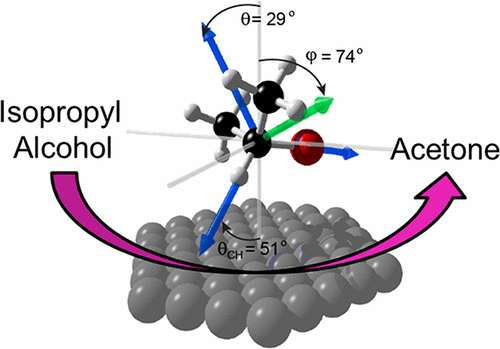当前位置:
X-MOL 学术
›
ACS Catal.
›
论文详情
Our official English website, www.x-mol.net, welcomes your
feedback! (Note: you will need to create a separate account there.)
Insight into the Selectivity of Isopropanol Conversion at Strontium Titanate (100) Surfaces: A Combination Kinetic and Spectroscopic Study
ACS Catalysis ( IF 11.3 ) Pub Date : 2017-10-30 00:00:00 , DOI: 10.1021/acscatal.7b02417 Shuai Tan 1 , Matthew B. Gray 2 , Michelle K. Kidder 1 , Yongqiang Cheng 3 , Luke L. Daemen 3 , Dongkyu Lee 4 , Ho Nyung Lee 4 , Ying-Zhong Ma 1 , Benjamin Doughty 1 , Daniel A. Lutterman 1
ACS Catalysis ( IF 11.3 ) Pub Date : 2017-10-30 00:00:00 , DOI: 10.1021/acscatal.7b02417 Shuai Tan 1 , Matthew B. Gray 2 , Michelle K. Kidder 1 , Yongqiang Cheng 3 , Luke L. Daemen 3 , Dongkyu Lee 4 , Ho Nyung Lee 4 , Ying-Zhong Ma 1 , Benjamin Doughty 1 , Daniel A. Lutterman 1
Affiliation

|
This work aims to better understand the role of interfacial molecular structure that governs selectivity and activity in heterogeneous catalytic reactions. To address this, a comprehensive study of isopropyl alcohol conversion over an archetypal perovskite material, strontium titanate (SrTiO3 or STO), was performed with an array of techniques sensitive to orthogonal aspects of the ensuing chemistry. Cubic-shaped STO nanoparticles with only the (100) facet exposed were synthesized and used to study the ensemble kinetic conversion of isopropyl alcohol over the surfaces, which showed selectivity to form acetone, with minor propylene products appearing at elevated temperatures. These results in combination with inelastic neutron scattering measurements provide not only insight into the selectivity and overall activity of the catalysts but also low-frequency vibrational signatures of the adsorbed and reacted species. To complement these measurements, pristine thin films of STO (100) were synthesized and used in combination with vibrational sum frequency generation spectroscopy to extract the absolute molecular orientation of the adsorbed molecules at the interface. It was found that the isopropyl alcohol assumes an orientation where the −CH group points toward the STO surface; this prereaction geometry offers an obvious pathway to produce acetone by abstracting the α proton and, thus, provides a mechanistic explanation of selectivity at STO (100) surfaces. This insight opens up pathways to explore and modify surfaces to tune the activity/selectivity through a molecular level understanding of the reactions at the surface.
中文翻译:

深入了解钛酸锶(100)表面上异丙醇转化的选择性:动力学和光谱研究的结合
这项工作旨在更好地了解在非均相催化反应中控制选择性和活性的界面分子结构的作用。为了解决这个问题,对原型钙钛矿材料钛酸锶(SrTiO 3或STO)是通过对随后的化学反应的正交方面敏感的一系列技术来执行的。合成了仅暴露(100)小面的立方形状的STO纳米粒子,并用于研究异丙醇在表面上的整体动力学转化,这表明形成丙酮的选择性,在升高的温度下会出现少量的丙烯产物。这些结果与非弹性中子散射测量结果相结合,不仅可以洞悉催化剂的选择性和整体活性,还可以洞悉吸附和反应的物质的低频振动信号。为了补充这些度量,合成了STO(100)的原始薄膜,并与振动和频率产生光谱结合使用,以提取界面处吸附分子的绝对分子取向。已发现异丙醇呈-CH基指向STO表面的取向。这种预反应几何结构提供了一条通过提取α质子产生丙酮的明显途径,从而提供了在STO(100)表面选择性的机理解释。这种见解开辟了探索和修饰表面的途径,通过对表面反应的分子水平的了解来调节活性/选择性。这种预反应几何结构提供了一条通过提取α质子产生丙酮的明显途径,从而提供了在STO(100)表面选择性的机理解释。这种见解开辟了探索和修饰表面的途径,通过对表面反应的分子水平的了解来调节活性/选择性。这种预反应的几何结构为通过提取α质子产生丙酮提供了一条明显的途径,从而为STO(100)表面的选择性提供了机械解释。这种见解开辟了探索和修饰表面的途径,通过对表面反应的分子水平的了解来调节活性/选择性。
更新日期:2017-10-30
中文翻译:

深入了解钛酸锶(100)表面上异丙醇转化的选择性:动力学和光谱研究的结合
这项工作旨在更好地了解在非均相催化反应中控制选择性和活性的界面分子结构的作用。为了解决这个问题,对原型钙钛矿材料钛酸锶(SrTiO 3或STO)是通过对随后的化学反应的正交方面敏感的一系列技术来执行的。合成了仅暴露(100)小面的立方形状的STO纳米粒子,并用于研究异丙醇在表面上的整体动力学转化,这表明形成丙酮的选择性,在升高的温度下会出现少量的丙烯产物。这些结果与非弹性中子散射测量结果相结合,不仅可以洞悉催化剂的选择性和整体活性,还可以洞悉吸附和反应的物质的低频振动信号。为了补充这些度量,合成了STO(100)的原始薄膜,并与振动和频率产生光谱结合使用,以提取界面处吸附分子的绝对分子取向。已发现异丙醇呈-CH基指向STO表面的取向。这种预反应几何结构提供了一条通过提取α质子产生丙酮的明显途径,从而提供了在STO(100)表面选择性的机理解释。这种见解开辟了探索和修饰表面的途径,通过对表面反应的分子水平的了解来调节活性/选择性。这种预反应几何结构提供了一条通过提取α质子产生丙酮的明显途径,从而提供了在STO(100)表面选择性的机理解释。这种见解开辟了探索和修饰表面的途径,通过对表面反应的分子水平的了解来调节活性/选择性。这种预反应的几何结构为通过提取α质子产生丙酮提供了一条明显的途径,从而为STO(100)表面的选择性提供了机械解释。这种见解开辟了探索和修饰表面的途径,通过对表面反应的分子水平的了解来调节活性/选择性。











































 京公网安备 11010802027423号
京公网安备 11010802027423号